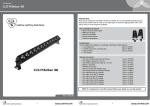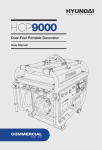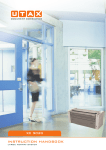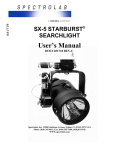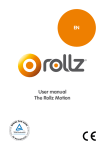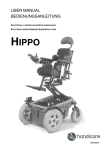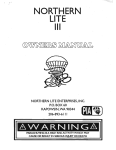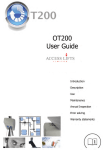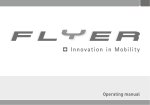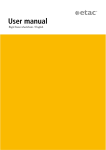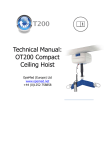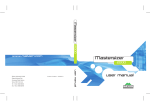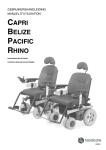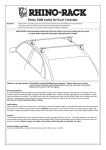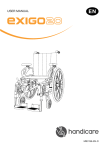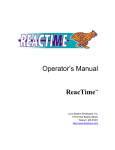Download User manual Kontiki
Transcript
USER’S DOCUMENTATION Wheelchair Kontiki ABOUT THIS DOCUMENTATION This documentation was compiled in English by: Wheelbase Products BV Version number: kontiki-user guide.doc Version date: October 2005 © Copyright: Wheelbase Products BV, Helmond, 2001. User Guide Wheelchair ‘Kontiki’ Nothing from this documentation may be reproduced, in whatever form, without permission from Wheelbase Products BV. An exception is made for those parts that are intended to be reproduced for the use of this documentation, such as concise instructions and indications on the wheelchair. WHEELCHAIR - IDENTIFICATION This users' documentation relates to the wheelchair type indicated on the front page. For further identification: See the specifications on the wheelchairs and/or the Declaration of Conformity (page 31) THE MANUFACTURER The wheelchair was manufactured by: Wheelbase Products BV Vossenbeemd 104 5705 CLHelmond Nederland Tel: +31 (0)492 593888 +31 (0)492 537931 THE SUPPLIER Dealer: Page 2 of 54 User Guide Wheelchair ‘Kontiki’ LIST OF CONTENTS About this documentation ............................................................................................1 Wheelchair identification ..............................................................................................2 The manufacturer ..........................................................................................................2 The supplier ...................................................................................................................2 Preface............................................................................................................................5 Reading directions ........................................................................................................5 Service and information................................................................................................5 1 Introduction ...........................................................................................................7 1.1 Purpose and function of the wheelchair..........................................................7 1.2 Versions and accessories...............................................................................7 1.2.1 Standard wheelchair and accessories................................................7 1.2.2 Options...............................................................................................7 2 Safety .....................................................................................................................8 2.1 2.2 2.3 2.4 3 Introduction.....................................................................................................8 Safety provisions ............................................................................................8 Safety rules.....................................................................................................8 Non-permissible use .......................................................................................8 Daily use .............................................................................................................. 10 3.1 3.2 3.3 3.4 3.5 3.6 3.7 3.8 3.9 3.10 3.11 3.12 3.13 Overview of operating controls ..................................................................... 10 Parking brake................................................................................................ 10 Getting into the chair..................................................................................... 11 Transfer ........................................................................................................ 11 Removal of armrest, legrest or headrest....................................................... 11 3.5.1 Removal of armrest.......................................................................... 11 3.5.2 Folding aside and removal of legrests.............................................. 12 3.5.3 Headrest .......................................................................................... 12 Height of push handgrips.............................................................................. 13 Comfort legrests (optional) ........................................................................... 13 Tilting angle adjustment................................................................................ 13 Using ......................................................................................................... 14 3.9.1 Kerbs................................................................................................ 14 3.9.2 Slopes .............................................................................................. 15 Getting out of the chair ................................................................................. 15 Transport by car or taxi................................................................................. 15 3.11.1 Chair only......................................................................................... 15 3.11.2 With user in the chair ....................................................................... 16 Storage . ..................................................................................................... 17 Cleaning ....................................................................................................... 17 Page 3 of 54 User Guide Wheelchair ‘Kontiki’ 3.14 Breakdowns .................................................................................................. 17 3.14.1 Tyre changing .................................................................................. 18 4 Adjustments ........................................................................................................ 19 4.1 Seat height ................................................................................................... 19 4.2 Seat depth .................................................................................................... 20 4.3 Seat width..................................................................................................... 21 4.3.1 Armrests........................................................................................... 21 4.3.2 Legrests ........................................................................................... 21 4.4 Back angle adjustment ................................................................................. 22 4.5 Legrests........................................................................................................ 23 4.6 Armrests ....................................................................................................... 23 4.7 Headrest (optional) ....................................................................................... 24 4.8 Pre-tensioning of spring damper................................................................... 26 4.9 Pre-setting of tilting angle ............................................................................. 26 4.10 Fixing of safety belt (optional) ....................................................................... 27 5 Repair and maintenance..................................................................................... 28 5.1 Periodic inspection........................................................................................ 28 5.2 Scrapping of the wheelchair ......................................................................... 28 6 Specifications...................................................................................................... 28 6.1 Technical specifications................................................................................ 29 6.2 Applied guidelines and standards ................................................................. 29 7 Indications on the wheelchair ............................................................................ 31 7.1.1 7.1.2 Type plate ........................................................................................ 31 Other indications .............................................................................. 31 EC Declaration of conformity................................................................................... 31 Appendix 1. Maintenance table.......................................................................... 32 Page 4 of 54 User Guide Wheelchair ‘Kontiki’ PREFACE This user's documentation describes the daily use and adjustment of the ‘Kontiki’ wheelchair'. Repair and maintenance must be carried out by your dealer. This documentation is part of the wheelchair! Keep this documentation in a safe place. It contains information that will be needed later, or is necessary for repair and maintenance. In case of transfer of ownership of the wheelchair this documentation has to be handed over with the chair. READING DIRECTIONS The sections of text of importance for the health and safety of personnel are printed in bold type, except in the chapter on safety itself. The following warning texts are used: TIP Specific instructions and/or explanatory information will follow this pictogram. ) Caution! This pictogram warns for possible damage to the wheelchair. Warning! This symbol warns for possible injury to persons. SERVICE AND INFORMATION For further information about the wheelchair, please contact your dealer (see page 2). Page 5 of 54 User Guide Wheelchair ‘Kontiki’ Guarantee and liability GUARANTEE Unless agreed otherwise in writing, the following guarantee conditions apply. • • • • • • • • The manufacturer gives a guarantee to your dealer of up to 12 months after delivery. Faults must be reported to your dealer before the period of guarantee has expired. The guarantee applies to faults that: • Occur during normal use of your wheelchair. • Are caused by material defects. • Are caused by manufacturing faults. The guarantee excludes faults caused by: • Normal wear and tear. • Incorrect use or misuse. • The use of consumables or accessories other than those prescribed. If faults occur the dealer will: • Replace the parts. • Repair the faults. • Opt for another solution if repair is, in all fairness, not possible. The user must give the manufacturer the opportunity to repair the faults. The guarantee conditions of the supplier involved apply to parts built in by a third party. The period of guarantee may differ from the period mentioned above. The manufacturer reserves the right to alter his wheelchairs without prior notice. Liability The manufacturer is not liable for unsafe situations, accidents or damage resulting from the ignoring of warnings or instructions such as are indicated on the wheelchair or in this documentation, for example: • incompetent or incorrect use or maintenance; • use for applications or under conditions other than those specified in this documentation; • the use of replacement parts other than those prescribed; • repair without the dealer's permission; • Alterations to the wheelchair. This includes: • alterations to the controls; • welding, mechanical processing and suchlike; • additions to the wheelchair or the controls. The manufacturer is not liable: • for damage resulting from faults or defects of the wheelchair (for example damage to products, factory stoppages, delays etc.). Page 6 of 54 User Guide 1 1.1 Wheelchair ‘Kontiki’ INTRODUCTION PURPOSE AND FUNCTION OF THE WHEELCHAIR The "Kontiki" wheelchair is a mobility aid for people with walking difficulties. The Kontiki is intended for indoor use and is operated and propelled by an accompanying person (push wheelchair). The hoop wheelchair is also suitable for propulsion by the user him/herself. Maximum weight of user is 120kg. 1.2 1.2.1 VERSIONS AND ACCESSORIES STANDARD WHEELCHAIR AND ACCESSORIES The Kontiki is available in two versions: • push wheelchair (small rear wheels) • hoop wheelchair (22" rear wheels) Both comprise: • a painted metal frame on wheels • seat, backrest, armrests, legrests • tiedown points for tying down in taxis The following loose-supplied items or tools come with every wheelchair. Check that they have been supplied. • This user documentation • Pump nipple for the tyres 1.2.2 OPTIONS There are many accessories and/or adaptations possible. Consult your dealer on these. Frequently used accessories include: • headrest • occupant restraint • comfort legrests, gas-spring operated Page 7 of 54 User Guide 2 2.1 Wheelchair ‘Kontiki’ SAFETY INTRODUCTION This wheelchair has been designed and built in such a way that it can be used and maintained in safety. This applies to the use, the conditions and the instructions as described in this documentation. Reading of this documentation and adherence to the instructions is therefore a must for all those who will be using this wheelchair 2.2 SAFETY PROVISIONS The wheelchair has the following safety provisions: • • • 2.3 • • • • • • • • • • • • • 2.4 Parking brake. Anti-tip supports to prevent tipping backwards. Attachment points for securing in taxis. SAFETY RULES Only persons who have read and understood the operating instructions may operate the wheelchair. The wheelchair is not a toy: ensure that children do not play with it. Do not climb or descend slopes steeper than 11º. Never mount or dismount a slope askew. Never mount or dismount kerbs of more than 8 cm. Always mount or dismount from a kerb backwards and at right angles, and not with one front wheel on the pavement and one front wheel on the road. Observe the traffic rules when using public roads. On pavements, maintain a safe distance between yourself and pedestrians, and be alert for sudden, unexpected movements by children. Ensure that the tyre pressures are correct (see chapter 6 or the sticker on your wheelchair). Safety provisions may not be removed or disabled. Safety may decrease with use. Ensure that maintenance is adequate. Do not use the wheelchair if the safety provisions are damaged or not in good working order. Ensure that the wheelchair is repaired. When taking a taxi, make use of the taxi’s tiedown system and safety belt. NON-PERMISSIBLE USE Attention is drawn to the following uses for which the wheelchair is not suitable: Page 8 of 54 User Guide • • • Wheelchair ‘Kontiki’ Using the wheelchair as a seat in a motor vehicle without using the tiedown hooks of the wheelchair and a suitable wheelchair-tiedown system, and occupant-restraint system in the car or taxi-bus. Transport of more than one person. Propulsion with the aid of another vehicle (for example, do not hold on to the back of a car). Page 9 of 54 User Guide 3 Wheelchair ‘Kontiki’ DAILY USE Generally speaking, every wheelchair is ready for use on leaving the factory. However, for optimum comfort and ease of use it is recommended that the dealer or therapist adjust the wheelchair to the personal characteristics and wishes of the user. See “Adjustment” on page 18. Before use read “Safety” on page 8. 3.1 OVERVIEW OF OPERATING CONTROLS Photo 3-1 Headrest (optional) Armrests Push handgrips Legrests Operating lever for tilt angle adjustment Push handgrip height adjustment Footplate (foldable) Brake pedal and handle 3.2 PARKING BRAKE Applying the brake: Push the brake pedal downward with your foot until the pedal remains in place. The rear wheels are now locked. Releasing the brake: Lift the brake upward with your foot. The brake can also be operated by hand. Applying the brake: Pull the brake handle to the rear. Releasing the brake: Push the brake handle forward. Page 10 of 54 User Guide 3.3 Wheelchair ‘Kontiki’ GETTING INTO THE WHEELCHAIR Before the user sits in the wheelchair: • Ensure that the parking brake is on. • Set the tilt angle adjustment in the neutral position (seat approximately horizontal). • Check the tyre pressures. Fold up the footplates and, if necessary, fold the legrests aside or remove them. The user can now sit in the wheelchair. 3.4 TRANSFER There are various possibilities for transferring into and out of the wheelchair: • Sideways transfer: remove one or both of the armrests: • Forward transfer: fold up the footplates and turn the legrests completely aside. 3.5 3.5.1 REMOVAL OF THE ARMREST, LEGREST OR HEADREST REMOVAL OF THE ARMREST Photo 3-2 Knob A Slacken knob A a couple of turns and remove armrest. Page 11 of 54 User Guide 3.5.2 Wheelchair ‘Kontiki’ FOLDING ASIDE AND REMOVAL OF LEGRESTS Photo 3-3 Handle A 1. Unlock the legrest by pushing handle A inwards. 2. Turn the legrest aside. 3. If necessary, remove the legrest by lifting it upwards. 3.5.3 HEADREST The headrest is fixed with a wingbolt. The headrest can be removed after the wingbolt has been slackened one turn. This knob can also be used to adjust the height of the headrest. However, it is often more useful to make a one-off height adjustment using the socket-head screws (see Headrest (optional)", on page 243). Then the headrest will always be in the correct position if it is pushed up to the stop in the attachment. Photo 3-4 Wingbolt for headrest Wingbolt for push handgrip Page 12 of 54 User Guide 3.6 Wheelchair ‘Kontiki’ HEIGHT OF PUSH HANDGRIPS The height of the push handgrips can be infinitely adjusted to suit the preferences of the carer. There are two wingbolts for this fitted to the frame tubes just under the handgrips (see Photo 3-4 above). 1. Slacken both bolts approximately one turn. 2. Set the handgrips to the desired height. 3. Re-tighten the bolts. 3.7 COMFORT LEGRESTS (OPTIONAL) The comfort legrest has a hinge point at knee-height, which can be adjusted using the available gas spring. 1. Push the gas spring handle to the rear so that the gas spring is unlocked. 2. Place the user’s knee in the required position. 3. Release the handle so that the gas spring is once more locked. Photo 3-5 Gas spring handle 3.8 TILT ANGLE ADJUSTMENT The wheelchair has been designed in such a way that the tilt angle can be adjusted with the user in the chair, using the minimum of effort. See Photo 3-1. 1. Hold the push handgrips firmly. 2. Pull up the tilt angle adjustment lever. 3. Tilt the chair to the required angle and release the handle. TIP Always return the tilt angle adjustment to the neutral position before the user gets out of the chair. Page 13 of 54 User Guide 3.9 Wheelchair ‘Kontiki’ USING 1. If needed, set the push handgrips at the required height (see "Height of push handg" on page 132. 2. Release the parking brake. 3. Propel the chair to the required place. 4. Re-apply the parking brake. Adjust the speed in bends, on slopes and when encountering obstacles. Never go through loose sand and, preferably, not through water. For the carer: Retain a hold on the push handgrips so long as the wheelchair’s parking brake has not been applied. Never walk faster than normal walking speed. Warning! Always use the parking brake when stopped. If one is not careful, the chair can begin to roll even on the slightest of slopes. A sharp bend can be taken provided the centre of the rear wheel is beyond, say, a doorpost. 3.9.1 KERBS The Kontiki has been designed to accept obstacles with a maximum height of 8 centimetres. However, it is recommended that the lowest possible point be chosen at all times. Moderate the speed when ascending or descending from a kerb and always take the kerb square on, rear wheels first. Warning! Caution: the anti-tip supports can touch the kerb when ascending/descending. Warning! Always ascend/descend a kerb backwards and square to the kerb so that both front wheels and both rear wheels retain simultaneous contact with the pavement or road. Page 14 of 54 User Guide 3.9.2 Wheelchair ‘Kontiki’ SLOPES The Kontiki has been designed to accept slopes of 11º (about 20%) with safety. Warning! Never take a slope askew as this increases the risk of tipping over. 3.10 GETTING OUT OF THE WHEELCHAIR 1. Apply the wheelchair’s parking brake. 2. Set the tilt angle adjustment to the neutral position. 3. Fold up the footplates, fold the legrests aside if necessary, and allow the user to get out of the chair. 3.11 TRANSPORT BY CAR OR TAXI Warning! Only lift the chair by the frame parts, not by the armrests, legrests or seat. 3.11.1 CHAIR ONLY • • Place the wheelchair in the transporting vehicle with the parking brake on. Make sure the wheelchair is secure, particularly if there is no separate luggage space (for example in a small bus). For transport purposes the backrest can be folded flat and other components can be removed. Folding the backrest flat 1. Click open the locking clip of the lower fork pin and remove the fork pin, see Photo 3-6 below. 2. Fold the backrest flat. 3. To avoid loss of the fork pin during transport it can be put back in position and locked. Page 15 of 54 User Guide Wheelchair ‘Kontiki’ Photo 3-6 Fork pin with locking clip See further: "Removal of the armrest, legrest or headrest" on page 11. 3.11.2 WITH THE USER IN THE CHAIR Warning! A wheelchair user may only be transported while sitting in the wheelchair if: • The car or taxi has been adapted for this purpose. • And the taxi has been fitted with a tiedown system. • And the user is secured with the aid of the car or taxi’s safety belt(s). Consult possible further instructions regarding wheelchair transport. In the Netherlands for example, the Code Veilig Vervoer Rolstoelinzittenden (VVR – Code for the Safe Transport of Wheelchair Occupants) 1. Place the wheelchair in the transporting vehicle with the parking brake on. 2. Lock the taxi’s safety belt(s). 3. Apply the taxi’s securing system. Warning! An eventual belt that is attached to the wheelchair itself is only a retention belt. It is not suitable as a safety belt. Page 16 of 54 User Guide Wheelchair ‘Kontiki’ The wheelchair is fitted with permanent tiedown points, located inside the rear wheels, for use with taxi tiedown system. For the method of securing in the car or taxi: see the instructions of the taxi tiedown system concerned. Photo 3-7 Tiedown point 3.12 STORAGE. Store the wheelchair in a dry, preferably slightly heated, room. 3.13 CLEANING Clean the wheelchair with a damp cloth. Eventual use can be made of a mild cleaning agent. Do not use an abrasive or aggressive cleaning agent. Use of a high-pressure cleaner is very strongly discouraged! 3.14 BREAKDOWNS Only the following breakdowns can be dealt with safely by the operatives: • Tyre changing Other breakdowns must be dealt with by dealer staff. Warning! If the breakdown occurs repeatedly it could point to a fault in the wheelchair: consult your dealer. Page 17 of 54 User Guide Wheelchair ‘Kontiki’ 3.14.1 TYRE CHANGING Only the rear wheels are fitted with pneumatic tyres. It is better to have the dealer change a tyre. If you intend changing the tyre yourself, work as follows: 1. 2. 3. 4. 5. 6. Remove the central dust cap from the rear wheel. Slacken the M12 axle bolt and remove the wheel from the hub. Deflate the tyre. Remove the old tyre and fit the new. Refit the wheel and replace the dust cap. Inflate the tyre (2,5 bar). Page 18 of 54 User Guide 4 Wheelchair ‘Kontiki’ ADJUSTMENTS The wheelchair can be adjusted to the personal characteristics or preferences of the user. This will generally be done by the dealer before, or at the time of, delivery. Later alterations can also be carried out by the therapist, who should have access to the following (generally available) tools: • Allen key, 4, 5 en 6 mm • Open-end spanner, 13 mm between flats There are a number of adjustments that may only be done by the dealer: these are indicated in the following paragraph. 4.1 SEAT HEIGHT The seat height can be adjusted to any one of 3 positions (approx. 40 mm apart). The factory setting is the mid-position. Alteration to the seat position must only be carried out by the dealer. Spring damper Photo 4-1 Height block (4x) Side frame Front socket-head screws (Rear hexagon-head bolts not shown) The seat height can be altered by changing the attachment of the 4 triangular shaped height blocks. 1. Decompress the spring damper as much as possible by setting the tilt angle adjustment to the extreme position (as far forward as possible). 2. Place the chair on blocks so that the wheels are free. 3. Loosen the parking brake handle forks. 4. Dismantle the side frames. These are fixed to the front height blocks with two socket-head screws each side, and at the rear with two hexagon-head bolts. 5. Alter the position of the 4 height blocks (attached with concealed socket-head Page 19 of 54 User Guide Wheelchair ‘Kontiki’ screws) as follows: To lower the seat: • Fit the height blocks with the concealed socket-head screw in the other hole. • Do not rotate the height blocks! To heighten the seat: • Fit the height blocks with the concealed socket-head screw in the other hole. • Rotate the height blocks through 180°! 6. Reassemble the side frames and the parking brake handle forks. 4.2 SEAT DEPTH The seat depth can be infinitely adjusted using the two socket-head screws (one on each side, see photo). 1. Slacken the screws one turn. 2. Slide the backrest to the required position. 3. Retighten the screws. The armrest depth can also be infinitely adjusted using the socket-head screws (two on each side), see Photo 4-4 on page 21. 4. Slacken screws (B) one turn. 5. Slide the armrest(s) to the required position. 6. Retighten the screws. Photo 4-2 Backrest Armrest Page 20 of 54 User Guide Wheelchair ‘Kontiki’ Photo 4-3 Backrest depth adjustment 4.3 4.3.1 SEAT WIDTH ARM RESTS The seat width of the armrests can be infinitely adjusted using the socket-head screws (two on each side, see photo) Photo 4-4 Socket-head screws A Socket-head screw B 1. Slacken socket-head screws (A) one turn, see Photo 4-4. 2. Slide the armrest to the required position. 3. Retighten the socket-head screws. 4.3.2 LEGRESTS The seat width for the legrests can be infinitely adjusted using the 4 socket-head screws (two on each side, see photo). Page 21 of 54 User Guide Wheelchair ‘Kontiki’ Photo 4-5 Socket-head screws 1. Slacken the socket-head screws about one turn. 2. Slide the legrest to the required position. 3. Retighten the socket-head screws. 4.4 BACKREST ANGLE ADJUSTMENT The angle between the seat and backrest can be infinitely adjusted. 1. Slacken the two lock nuts, see photo. ) Caution! One of the two lock nuts is left-hand thread! 2. Rotate the black centre section until the required backrest angle is reached. 3. Retighten the lock nuts. Page 22 of 54 User Guide Wheelchair ‘Kontiki’ Photo 4-6 Lock nut Central strut Lock nut 4.5 LEGRESTS Photo 4-7 Setscrews C Bolt B Setscrew A Lower leg length 1. Slacken setscrew A. 2. Set the required lower leg length. 3. Retighten the setscrew. Ankle hinge 1. Slacken bolt B but do not remove. 2. Set the required angle using the two setscrews C. 3. Retighten bolt B. 4.6 ARMRESTS Page 23 of 54 User Guide Wheelchair ‘Kontiki’ Photo 4-8 Hexagon-head bolt B Socket-head screw A Armrest height adjustment 1. Slacken socket-head screw A. 2. Set to the required height. 3. Retighten the screw. Armrest angle adjustment 1. 2. 3. 4. Slacken socket-head screw A. Slacken the two hexagon-head bolts B. Move the armrest to the required angle. Retighten screw/bolts A and B. 4.7 HEADREST (OPTIONAL) Photo 4-9 3 socket-head screws Wingbolt 1. Slightly loosen the 3 socket-head screws in the headrest bracket. Page 24 of 54 User Guide Wheelchair ‘Kontiki’ 2. The headrest can now be moved to any desired position: Set the headrest to the required height, depth and angle. 3. Retighten the 3 socket-head screws. Page 25 of 54 User Guide 4.8 Wheelchair ‘Kontiki’ PRE-TENSION SPRING DAMPER Photo 4-10 Helical spring Spring seat Spring spindle 1. Ensure that the tilt angle spring is unloaded: no one in the wheelchair and the tilt angle adjusted to the extreme forward position. 2. Rotate the helical spring to alter the pre-tension (the spring seat will rotate with the spring): o Rotate right to increase the pre-tension. o Rotate left to decrease the pre-tension. The spring spindle must not rotate. If necessary, prevent this by inserting a pin in the hole. 4.9 PRE-SETTING OF TILT ANGLE This setting may only be carried out by the dealer. The factory pre-setting is such that the chair seat is approximately horizontal and in the extreme forward position of the tilt angle adjustment. Photo 4-11 Spring Spindle To alter the pre-setting: Page 26 of 54 User Guide • • Wheelchair ‘Kontiki’ Insert a pin (a screwdriver for example) in the hole in the spring spindle. Use this to rotate the spring spindle to the required position. o To the right for a reduced seat angle. o To the left for an increased seat angle. 4.10 OCCUPANT RESTRAINT ATTACHMENT (OPTIONAL) Two M8 threaded holes have been provided for the attachment of an occupant restraint. Photo 4-12 Attachment point for occupant restraint (also on other side) Warning! The passenger restraint does not replace a vehicle’s safety belt system (for this see "Transport by car or taxi" on page 15). Page 27 of 54 User Guide 5 Wheelchair ‘Kontiki’ REPAIR AND MAINTENANCE Repairs must be carried out by the dealer. All replacement parts must be at least up to the specifications of the original parts. All parts can be ordered from Wheelbase Products BV. Warning! Deviations from these instructions can affect the safety of the wheelchair. Such deviations exonerate Wheelbase Products BV from all liability. We advise you to keep a logbook in which all work carried out on your Kontiki can be recorded. See “Maintenance table” on page 32. 5.1 PERIODIC INSPECTION The wheelchair must be inspected by the owner at least once per year. He will take care of any adjustments or repairs. Points for attention during this inspection include: • Operation of all functions. • Tyres. • Adjustment of parking brake (adjusting nuts inside the rear wheels). • Adjustment handle for adjusting the tilt angle (adjust so that there is no play in the handle). • Check for corrosion and damage. 5.2 DECOMMISSIONING OF THE WHEELCHAIR If the wheelchair has to be scrapped, the waste processing instructions in force at the time and place of the scrapping must be taken into account. Only generally familiar materials have been used in the manufacture of the wheelchair. At the time of manufacture there were waste processing possibilities in existence for these materials, and there were no particular risks known for the persons tasked with the carrying out of the scrapping. Page 28 of 54 User Guide 6 Wheelchair ‘Kontiki’ SPECIFICATIONS 6.1 TECHNICAL SPECIFICATIONS Fabrikant: . Adres:. Model: . Maximum User weight: ISO standaard 7176-5 7176-5 7176-5 7176-7 (Dis 1998) 7176-7 (Dis 1998) 7176-7 (Dis 1998) 7176-7 (Dis 1998) 7176-7 (Dis 1998) 7176-7 (Dis 1998) 7176-7 (Dis 1998) 7176-7 (Dis 1998) 7176-7 (Dis 1998) 7176-7 (Dis 1998) 7176-7 (Dis 1998) 7176-7 (Dis 1998) 7176-5 Wheelbase Products B.V. Vossenbeemd 104 5705 CL Helmond Kontiki 120 ... kg (used dummy mass for iso tests ) Overall length (with stand. Legrests) Total width minimum 1085mm 635mm maximum 1293mm 700mm 44kg 36kg -- Total mass Mass heaviest part (na verkleinen) Seat anglehoek Effective seatdepth Effective seatwidth Seat height on top of seatcushion ( 0 degrees) Backrest angle (tool) adjustable Backrestheight (measured of top seatcushion) Fibula length Legrestangle Armrest to seat distance (height) Front locarion of armrest structure 420mm 370 500mm 90° 550mm 420mm 28° 175mm 60mm Minimum Turningdiameter (diameter totaal) mm mm 1800mm kg 0 22° 540mm 540mm 580mm 120° 550mm 540mm ° 275mm -- The wheelchairconforms the following standards: • Requirements and test methods for static, impact and fatigue strengths ISO 7176-8, Yes • Requirements for resistance to ignition in accordance with ISO 7176-16. Ja Push chair intended for use in and around the house and on the street. The attendat can tilt the seating unit in order to vary the sitting posture of the user. The backrest angle can be adjusted with fixed settings(non fixed setting as an option) The armrests and legrest are adjustable. The armrests and legrests are detachable by an attendant to enable a transfer. Types are available that may or may not be reduced in size. 6.2 APPLIED GUIDELINES AND STANDARDS This wheelchair carries the CE mark. This means that the wheelchair satisfies the applicable European guidelines with regard to safety and health. The “Declaration of Conformity” (see page 31) indicates these guidelines. The standards applied are also given in the "Declaration of Conformity". Page 29 of 54 User Guide Wheelchair ‘Kontiki’ In addition, the wheelchair meets the: • GQ (Inspection specification R-06 from the KBOH) Page 30 of 54 User Guide 7 7.1.1 Wheelchair ‘Kontiki’ INDICATIONS ON THE WHEELCHAIR TYPE PLATE The type plate bears the following information: Wheelbase Products BV Vossenbeemd 104 5705 CL Helmond Netherlands Type: Kontiki Serial number: Max. user weight: 120 kg Area of operation: indoors Year: Some details on the type plate are not common to all wheelchairs supplied and have therefore been omitted from the above. The actual details of your wheelchair can be found on its type plate. 7.1.2 OTHER INDICATIONS Indication Meaning max. 2,5 bar (with 12,5" wheels) max. 4,5 bar (with 22" wheels) Maximum air pressure in the tyres Footbrake 1: on 2: off Tilt angle adjustment Back angle adjustment Tension adjustment sprin-damper Attachment points for taxi tiedown system Page 31 of 54 User Guide Wheelchair ‘Kontiki’ EC DECLARATION OF CONFORMITY Concerning the Medical Devices Directive. We Wheelbase Products BV Vossenbeemd 104 5705 CLHelmond Nederland Tel: +31 (0)492 593888 +31 (0)492 537931 declare entirely under our own responsibility: 1- We are the manufacturers of the medical device: Wheelchair Mark: Type: Serial no.: Wheelbase Kontiki all serial numbers of this type to which this declaration refers. 2- The wheelchair has been designed and built conforming to the requirements of the Medical Devices Directive 93/42/EC. 3- The wheelchair has been designed and built in accordance with the (European) Standards or standard documents: 2nd Dev. NEN-EN 12182:1997 NEN-EN 12183: 1999 NEN-EN 1441:1997 NEN-EN 1041:1998 Technical aids for the disabled Hand-propelled wheelchairs Medical aids – Risk Analysis Information supplied by the manufacturer together with the medical aids Signed at Date: Helmond ... Signed by: Position: D. G. J. van de Beek Director Page 32 of 54 User Guide APPENDIX 1. Wheelchair ‘Kontiki’ MAINTENANCE TABLE All the work carried out on your Kontiki can be recorded in this table. Serial number: ............... Date Date of commissioning: ................ Work description Carried out by Page 33 of 54 User Guide Wheelchair ‘Kontiki’ SUPPLEMENT USER’S DOCUMENTATION Wheelchair Kontiki, motor-assisted Page 34 of 54 User Guide Wheelchair ‘Kontiki’ Vossenbeemd 104 (t) +31 (0)492 593888 Chamber of Commerce Oost VAT No. 807 602 486 B01 5705 CG Helmond (f) +31 (0)492 537931 Brabant 17112719 ABN AMRO 536646464 www.wheelbase.nl ABOUT THIS DOCUMENTATION This documentation was compiled in English by: Wheelbase Products BV Version reference : kontiki-motor-assisted.doc Version date : June 2004 © Copyright : Wheelbase Products BV, Helmond, 2003. No part of this documentation may be reproduced, in any form, without the permission of Wheelbase Products BV. An exception is made for parts of the documentation which are intended to be reproduced for the benefit of using the documentation, such as concise instructions and indications on the wheelchair. WHEELCHAIR IDENTIFICATION This user’s documentation relates to wheelchairs of the type indicated on the front page. For further identification: See the details on the model plate on the wheelchair and/or the Declaration of Conformity (page 51) THE MANUFACTURER The wheelchair was manufactured by: Wheelbase Products BV Vossenbeemd 104 5705 CL Helmond The Netherlands Tel: +31 (0)492 593888 Fax: +31 (0)492 537931 THE SUPPLIER Dealer: Page 35 of 54 User Guide Wheelchair ‘Kontiki’ LIST OF CONTENTS About this documentation ............................................................................................2 Wheelchair Identification ..............................................................................................2 The Manufacturer ........................................................................................................ 35 The Supplier................................................................................................................. 35 Preface............................................................................................................................5 Reading Directions........................................................................................................5 Service and Information.............................................................................................. 38 Guarantee and Liability ............................................................................................... 39 1 Introduction ......................................................................................................... 39 1.1 Purpose and function of the wheelchair........................................................ 39 1.2 Versions and accessories...............................................................................6 1.2.1 Standard wheelchair and accessories.............................................. 39 The standard wheelchair consists of:............................................................ 39 1.2.2 Options...............................................................................................7 2 Safety .....................................................................................................................8 2.1 2.2 2.3 2.4 3 Introduction................................................................................................... 41 Safety features ............................................................................................. 41 Safety rules.....................................................................................................8 Non-permitted use ........................................................................................ 42 Daily Use .............................................................................................................. 43 3.1 3.2 3.3 3.4 Overview of operating controls ..................................................................... 43 Driving the wheelchair using the motor......................................................... 43 Getting out of the wheelchair ........................................................................ 44 Breakdowns… .............................................................................................. 11 4 Adjustments ........................................................................................................ 46 5 Batteries and Recharger..................................................................................... 46 5.1 Batteries ....................................................................................................... 12 5.2 Charger......................................................................................................... 46 6 Repairs and Maintenance ................................................................................... 47 6.1 Periodic inspection........................................................................................ 47 6.2 Disposing of the wheelchair .......................................................................... 13 7 Specifications...................................................................................................... 49 7.1 Technical specifications................................................................................ 49 Page 36 of 54 User Guide 8 Wheelchair ‘Kontiki’ Indications on the Wheelchair ........................................................................... 50 8.1.1 8.1.2 Model plate ...................................................................................... 15 Other indications, labelling ............................................................... 50 EC Declaration of Conformity..................................................................................... 51 Appendix 1. Maintenance log ............................................................................. 17 Page 37 of 54 User Guide Wheelchair ‘Kontiki’ PREFACE This user’s documentation describes the daily use of and adjustments to the ‘motorassisted Kontiki'. Repairs and maintenance are to be carried out by your dealer. This documentation is a part of the wheelchair! Therefore be sure to keep this documentation in a safe place. It contains information which may be useful or necessary at a later date, for example, information on adjustments or maintenance. This documentation must be included in any transfer of ownership of the wheelchair. READING DIRECTIONS The sections of text which are of importance in terms of human safety and health are printed in bold type, with the exception of the chapter on safety itself. The following warning texts are used: TIP This pictogram indicates specific instructions and/or explanatory information. ) Caution! This pictogram warns against possible damage to the wheelchair. Warning! This symbol warns against possible injury to people. SERVICE AND INFORMATION For further information on the wheelchair please contact your dealer (see page 2). Spare parts are available via your dealer. Page 38 of 54 User Guide Wheelchair ‘Kontiki’ GUARANTEE AND LIABILTY The terms of guarantee and liability for the ‘Kontiki, motor-assisted’ are identical to those for the Kontiki. 8 8.1 INTRODUCTION PURPOSE AND FUNCTION OF THE WHEELCHAIR The ‘Supplement user’s documentation Kontiki, motor-assisted’ should be considered as a supplement to the user’s documentation for the Kontiki. The purpose of this supplement is to describe and explain elements which are only included in the Kontiki, motor-assisted, such as the driving motor and the batteries. Both the user’s documentation for the Kontiki and this Supplement must be supplied with the ‘Kontiki, motor-assisted’. The ‘Kontiki, motor-assisted’ is a mobility aid for the assistants of wheelchair users who have difficulty in pushing a wheelchair. The motor powers the wheelchair so that it almost drives itself. When the red handle is squeezed the chair moves forward. The assistant can simply steer and if necessary can brake by releasing the handle again. Otherwise the wheelchair has the same purpose and the same function as the Kontiki. 8.2 VERSIONS AND ACCESSORIES 8.2.1 STANDARD WHEELCHAIR AND ACCESSORIES The standard version consists of: • a painted metal frame on wheels • seat, backrest, armrests, leg rests and headrest • powered rear wheels (+ driving motor), front wheels • batteries (supplied with the wheelchair by the dealer) • operating panel and a (red) handle for accelerating The following parts or tools are part of this wheelchair and are supplied as separate parts together with the wheelchair. Check to see that they have been supplied: • user’s documentation Kontiki • this supplement for the Kontiki, motor-assisted • pump valve for the tyres • battery charger with user’s documentation (supplied by your dealer) • ignition key Page 39 of 54 User Guide Wheelchair ‘Kontiki’ 8.2.2 OPTIONS The following accessories are available: • various seating elements • posture belt • attachment points for securing the chair in taxis • comfort leg rests, gas-spring operated Page 40 of 54 User Guide 9 9.1 Wheelchair ‘Kontiki’ SAFETY INTRODUCTION This wheelchair has been developed and built to ensure safety in use and maintenance. This applies to the use, conditions and instructions as described in this documentation. The reading of this documentation and adherence to the instructions are therefore a must for anyone using this wheelchair. 9.2 SAFETY FEATURES The wheelchair features the following safety provisions: • • • • 9.3 • • • • • • • • • • • • • • • • Parking brake. Ignition switch Anti-tip supports to prevent the wheelchair tipping over backwards. Attachment points for securing the wheelchair in taxis. SAFETY RULES Only those persons who have read and understood the operating instructions may use the wheelchair. When using the wheelchair in strong sunlight take into account the fact that the contact surfaces of the seat, back and armrest material may become warm. The wheelchair is not a toy: do not allow children to play with it. Never turn off the motor by removing the ignition key while riding. Using the tip adjustment on slopes can compromise the stability of the chair. Never ascend or descend a slope at an angle. Never mount or dismount a kerb higher than 8 cm. Observe the highway code when using public roads. Keep a safe distance from pedestrians when using pavements and watch out for any unexpected movements by children. Ensure that the tyre pressures are correct (see the sticker on the wheelchair). Wet batteries are not to be used. Acids and vapours can be released if wet batteries are used. Safety features may not be removed or deactivated. By prolonged use safety may decrease. Ensure that the wheelchair is properly maintained. Do not use the wheelchair if safety features are damaged or are not in good working order. Ensure that the wheelchair is repaired. Use the taxi tying down facility and safety belt when travelling by taxi. Prevent overtaxing your wheelchair by avoiding extreme situations (such as, for example, ascending a steep slope at maximum speed over a prolonged period of time) Page 41 of 54 User Guide • • • • • 9.4 Wheelchair ‘Kontiki’ The battery capacity of your wheelchair decreases with cold weather; keep this in mind when planning your journey. Under freezing conditions keep an eye on the battery indicator! The wheelchair has been designed for outdoor use and can withstand rain and dust. However, under extreme conditions damp or dirt can penetrate. Therefore avoid prolonged riding in heavy rain, and riding through deep puddles, mud, high grass, snow and similar. It is not advisable to ride through loose sand. Adjust your speed when riding indoors. Turn the wheelchair off when standing still for a longer period of time: this prevents your clothes or the clothes of others getting caught up, which may cause the wheelchair to be set in motion inadvertently. NON-PERMITTED USE Attention is drawn to the following applications for which the wheelchair is not suitable: • • • • The transport by car or taxibus of a user seated in the wheelchair without making use of the taxi’s tying down system or of the seatbelts of the car or taxibus. The transport of more than one person. Riding with the aid of another vehicle (for example, holding on to the back of a car). Moving other vehicles (for example, pulling a trailer). Page 42 of 54 User Guide Wheelchair ‘Kontiki’ 10 DAILY USE In general each wheelchair is ready for use on leaving the factory. However, for optimal comfort and ease of use it is recommended that the dealer or therapist adjusts the wheelchair to the user’s personal characteristics and preferences. See “Adjustments” on page 12. Before use read "Safety" on page. 10.1 OVERVIEW OF OPERATING CONTROLS (red) handle driving motor (right) Headrest push handles (left and right) height adjustment push handles handle for tilt adjustment (left) armrest leg rests motor Figure 1 10.2 5. 6. 7. 8. 9. DRIVING THE WHEELCHAIR USING THE MOTOR Insert the ignition key into the ‘switch’ on the operating panel. Check the speed of the wheelchair and adjust to the current surroundings Squeeze the right-hand (red) handle to set the wheelchair in motion Apply the brake to the wheelchair when you have stopped moving Remove the ignition key from the switch When going around corners, up or down slopes or around obstacles, adjust speed appropriately. Do not drive through loose sand and preferably not through water. For the assistant: Page 43 of 54 User Guide Wheelchair ‘Kontiki’ Keep hold of the push handles whenever the parking brake is not applied. Do not walk faster than normal walking speed. Warning! When standing still always use the parking brake. The wheelchair can start to move, even on a slight incline, if due care is not taken. A sharp turn can be made if the centre of the rear wheels is beyond a doorpost, for example. Figure 2 (Operating panel Kontiki, motor-assisted) 10.3 4. 5. 6. 7. GETTING OUT OF THE WHEELCHAIR Apply the parking brake Remove the ignition key from the ignition switch Set the tilt angle adjustment to the neutral position. Fold up the footplates, and, if necessary, fold aside the leg rests. The user can now get out of the wheelchair. 10.4 BREAKDOWNS It is only safe for users to deal with the following breakdowns: • Changing tyres; see the user’s documentation for the Kontiki. All other breakdowns must be dealt with by dealer personnel. Warning! If a breakdown recurs repeatedly this may be an indication of a fault in the wheelchair: consult your dealer. Page 44 of 54 User Guide Wheelchair ‘Kontiki’ Page 45 of 54 User Guide Wheelchair ‘Kontiki’ 11 ADJUSTMENTS Please refer to the user’s guide for the Kontiki for adjustments to the wheelchair. 12 BATTERIES AND CHARGER 12.1 BATTERIES The battery charging socket is located on the front of the wheelchair’s operating panel, next to the ignition switch. See figure 3. If you use the wheelchair on a daily basis it is advisable to recharge it every night. Figure 3 12.2 CHARGER Recharge the batteries in the following way: • Turn the wheelchair off. • Insert the charging plug into the charging socket, see Figure 1 above. Turn the charger on (see the instruction manual for your battery charger). • When recharging is complete (see the instruction manual for your battery charger), turn the charger off and remove the charging plug from the charging socket. Always fully recharge the batteries; recharging for an hour will have a negative effect on the life and performance of the (dry) batteries. It is not possible to use the wheelchair while recharging. ) Caution! It is recommended to recharge the batteries regularly, even if you do not use the wheelchair for a longer period of time (approx. every three weeks). This is to ensure that there is no reduction in the battery capacity. Page 46 of 54 User Guide Wheelchair ‘Kontiki’ 13 REPAIRS AND MAINTENANCE Repairs must be carried out by the dealer. All replacement parts must meet at least the specifications of the original parts. All parts can be ordered from Wheelbase Products BV. Warning! Non-adherence to these instructions can have consequences for the safety of the wheelchair. Wheelbase Products BV can accept no liability for this. The service handbook is not yet available. You are advised to note any work carried out on your motor-assisted Kontiki in a logbook. See "Maintenance Log" on page 17. 13.1 PERIODIC INSPECTION The wheelchair must be inspected by the dealer as least once a year. The dealer will take care of any adjustments or repairs. The following are among the points to be taken into consideration during inspection: • Operation of all functions • Tyres • Adjustment of the parking brake (adjusting nuts on the inside of the rear wheels). • Adjustment of the handle for the tilt angle adjustment (to be adjusted so that there is no play in the handle) • Adjustment of the motor and the control functions of the operating panel. • A check for corrosion and damage 13.2 DISPOSING OF THE WHEELCHAIR If the wheelchair is to be scrapped then the regulations for the disposal of goods valid in the place of and at the time of disposal must be observed. Only generally known materials have been used in the manufacture of the wheelchair. At the time of manufacture means of disposal were in existence and there were no particular risks known to personnel charged with carrying out disposal. Warning! The battery unit of the wheelchair must be regarded as chemical waste and disposed of in the appropriate manner. Page 47 of 54 User Guide Wheelchair ‘Kontiki’ The batteries are recyclable. Page 48 of 54 User Guide Wheelchair ‘Kontiki’ 14 SPECIFICATIONS 14.1 TECHNICAL SPECIFICATIONS Manufacturer: Wheelbase Products B.V. Address:. Vossenbeemd 104 5705 CG Helmond Model: Kontiki, motor-assisted Maximum user weight: 120 kg The ‘Kontiki, motor-assisted’ uses two 28 amp batteries. These are dry batteries. As mentioned earlier in this supplement, it is important to recharge the batteries fully on a regular basis. The batteries are located under the seat; in Figure 1 above they are indicated as ‘motor’. The battery charger is a 5,5 amp charger complying to standard CE IP 205. Recharging the batteries is discussed in paragraph 5.2. Page 49 of 54 User Guide Wheelchair ‘Kontiki’ 15 INDICATIONS ON THE WHEELCHAIR 15.1.1 MODEL PLATE The model plate includes the following information: Wheelbase Products BV Vossenbeemd 104 5705 CL Helmond Netherlands Type: Kontiki, motor-assisted Serial number: Max. user weight: 120 kg Area of usage: indoors Year: Some of the details on the model plate vary from wheelchair to wheelchair. These details have not been mentioned above. You can find the actual details for your wheelchair on the model plate. 15.1.2 OTHER INDICATIONS, LABELLING Indication Meaning max. 2.5 bar (for 12,5" wheels) Maximum air pressure for the tyres: max. 4.5 bar (for 22" wheels) Footbrake 1: on 2: off Tilt angle adjustment Warning tilt angle adjustment use on slopes (instability) Adjustment for pre-set tension of spring cushioning Warning; Possible fingertrap Back angle adjustment Page 50 of 54 User Guide Wheelchair ‘Kontiki’ EC DECLARATION OF CONFORMITY Concerning the Medical Devices Directive We Wheelbase Products BV Vossenbeemd 104 5705 CLHelmond Nederland Tel: +31 (0)492 593888 +31 (0)492 537931 certify, entirely under our own responsibility: 1- We are the manufacturers of the medical device: Wheelchair Brand name: Wheelbase Model: Kontiki, motor-assisted Serial no.: all serial numbers for this model to which this declaration refers. 2- The wheelchair has been designed and manufactured in accordance with the requirements of the Medical Devices Directive 93/42/EEG 3- The wheelchair has been designed and built in accordance with (European) Standards or standard documents: 2nd Dev NEN-EN 12182:1997 NEN-EN 12183:1999 NEN-EN 1441:1997 NEN-EN 1041:1998 Signed at Date: Technical aids for the disabled Hand-propelled wheelchairs Medical aids – Risk analysis Information supplied by the manufacturer together with the medical aids Helmond ... .... Signed by: D. G. J. van de Beek Page 51 of 54 User Guide Position: Wheelchair ‘Kontiki’ Director Page 52 of 54 User Guide Wheelchair ‘Kontiki’ APPENDIX 1 MAINTENANCE LOG You can record all work carried out on your Kontiki in this log. Serial number: ............... Date Date wheelchair came into use: ................ Description of work carried out Carried out by Page 53 of 54 User Guide Wheelchair ‘Kontiki’ Page 54 of 54























































